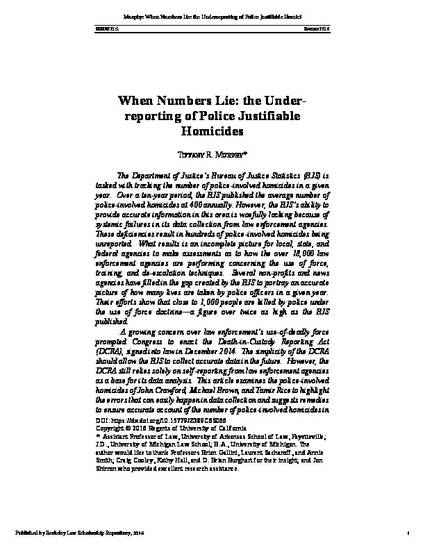
Article
When Numbers Lie: the Under-reporting of Police Justifiable Homicides
Berkeley Journal of Criminal Law
(2016)
Abstract
The Department of Justice’s Bureau of Justice Statistics (BJS) is tasked with tracking the number of police-involved homicides in a given year. Over a ten-year period, the BJS published the average number of police-involved homicides at 400 annually. However, the BJS’s ability to provide accurate information in this area is woefully lacking because of systemic failures in its data collection from law enforcement agencies. These deficiencies result in hundreds of police-involved homicides being unreported. What results is an incomplete picture for local, state, and federal agencies to make assessments as to how the over 18,000 law enforcement agencies are performing concerning the use of force, training, and de-escalation techniques. Several non-profits and news agencies have filled in the gap created by the BJS to portray an accurate picture of how many lives are taken by police officers in a given year. Their efforts show that close to 1,000 people are killed by police under the use of force doctrine—a figure over twice as high as the BJS published.
A growing concern over law enforcement’s use-of-deadly force prompted Congress to enact the Death-in-Custody Reporting Act (DCRA), signed into law in December 2014. The simplicity of the DCRA should allow the BJS to collect accurate data in the future. However, the DCRA still relies solely on self-reporting from law enforcement agencies as a base for its data analysis. This article examines the police-involved homicides of John Crawford, Michael Brown, and Tamir Rice to highlight the errors that can easily happen in data collection and suggests remedies to ensure accurate account of the number of police-involved homicides in a given year. The success of the DCRA depends on diversification of data collection similar to non-profits and media which have greater accuracy and detail concerning police involved homicides. The BJS must adopt broader data collection protocols to ensure data accuracy and allow governmental agencies to make appropriate policy assessments based on that data. Only then can effective changes in police officer training on use of force help to curb the high number of deaths each year.
Keywords
- Homicide,
- Criminal law,
- Criminal procedure,
- Police
Disciplines
Publication Date
Spring 2016
Citation Information
Tiffany R Murphy. "When Numbers Lie: the Under-reporting of Police Justifiable Homicides" Berkeley Journal of Criminal Law Vol. 21 (2016) p. 42 Available at: http://works.bepress.com/tiffany_murphy1/9/
